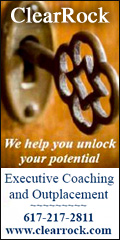NEHRA News
Northeast Human Resources Association
HR professionals often shy away from — or freak out about — these lofty, pie-in-the-sky exercises. But it is essential for constructing a focused and comprehensive strategic vision for HR. If your organization, like many, boasts that its people are the differentiator, then this is essential for the entire organization. Of course, if your organization is developing a company-wide strategic vision, your leadership team may be coming to you with these questions. Be one step ahead of your CEO and present him/her with your answers (instead of scrambling to think of something!). The questions are centered around the most important people issues — retention, recruitment and leadership.
Who do we keep?
Who will we hire?
Who will lead?
Who do we keep?
Of course, the answers to any of these three
question must be closely aligned with the company’s business plan and strategic
direction. In order to know who you want to retain, you need to have a vision
of where the organization’s growth will be. What are the company’s business
goals? What parts of the business will be developed over the next few years?
Which of your current employees will help you reach those goals?
Once you’ve identified your MVPs, you need to develop strategies for keeping them.
You must implement the programs that are important to people. It has been proven countless times that money and perks aren’t what keep employees engaged. Employees would skip a free lunch in favor of a stretch assignment and other development opportunities. There needs to be a company-wide commitment for education and training opportunities. Employees want to hone their skills so they can be more marketable. (This is also how you develop your leaders.)
Equally important is to answer, who do we not want to keep? Some people have
skills that may need to be phased out. This doesn’t mean wide-spread lay-offs.
Your organization can take a more subtle approach. You could have a planned
attrition, where you stop hiring for certain positions and skill sets, or
active attrition where you can help people find external opportunities.
Who will we hire?
If you haven’t hired in a while, you will need to look at your hiring
competencies. The skills and experience you hired for five years ago, may not
be what you need this year or in the future. Unfortunately, many managers are
so focused on immediate need, they hire to solve yesterday’s problems. In this
time of economic thrift, it makes sense to hire for what the organization will
need in the months and years ahead.
What are the competencies the organization, and each department, will need
to grow moving forward? Does the organization have enough diversity in its’
employee base? What skill sets will be most in demand? Will the business model
change? If so, can we fill the need? Where can we recruit these people?
Who will lead?
Take a look at the leadership team. Where are the holes? How will the make-up
change over the next several years? Who will be the next CEO? Will you hire a
CEO or develop a current employee to take on the role? Sometimes when you bring
a CEO into an organization, it just doesn’t stick. It may be a better strategy
to bring in a VP level person and groom him or her to become the CEO. This is
why it’s important to do internal development to craft the kind of leaders the
organization needs, and to take a long term view of recruitment.
Make sure to have a succession plan in place for every member of the leadership team, and a back-up plan in case of changes. This exercise shouldn’t be reserved for just the top, but for every senior manager in the company. In IT, finance, sales, marketing: who will the next leader be? Where are we finding our leaders? Internal development becomes vital to organization because they can grow the type of leaders your organization needs.
Organizations should strive to be more fluid, so a sudden departure doesn’t devastate a company or department. Back-fill positions and try cross-over assignments so employees are well-versed in more than one role.
By asking your team these three tough questions, you can help your organization reach its goals, differentiate your company by putting your people first, and give your HR career a boost by earning a spot at the leadership table.
Unfortunately, many companies have fewer resources to devote to selection, succession and leadership development initiatives to help ensure that their leaders are set up for success and able to effectively handle these challenges. In this environment, an understanding of which attributes (competencies) make the difference in a leader’s effectiveness, and the extent to which this varies by industry, can help organizations prioritize their talent management efforts to ensure initiatives are high impact and yield the greatest return on investment.
To shed light on the
competencies that differentiate top performing leaders, data was collected on
the managerial effectiveness of over 1,000 leaders across organizations
including multi-nationals, Fortune 1000 and non-profits.
Of 50 competencies, three emerged as the factors that differentiate the most effective leaders across industries. The results suggest that these leaders are able to balance execution-oriented behaviors with the interpersonal skills required to build strong relationships. The three competencies are:
1. Building trust and demonstrating personal accountability (e.g., keeping promises and honoring commitments, accepting responsibility for one’s actions, communicating honestly)
2. Action orientation (e.g., maintaining a sense of urgency, acting decisively to implement solutions and resolve crises)
3. Flexibility and agility (e.g., adjusting one’s behavior to changing circumstances, remaining open to new ways of doing things, working effectively in an unstructured, matrixed or dynamic environment)
Given that these three competencies have such a strong impact on a leader’s effectiveness, what are the implications for talent management? For one, organizations would benefit from devoting equal time and resources to help leaders develop these competencies early in their careers. Following are additional considerations for talent management organized by competency.
The ability to build trust and demonstrate personal accountability is the foundation for leadership success.
While the ability to build trust
and demonstrate personal accountability may seem fundamental, its impact cannot
be underestimated. Numerous studies have shown that increased accountability
leads to enhanced team performance. When a leader fails to take accountability
for his or her actions, it can lead to a "culture of blame" where trust is
eroded and finger pointing and avoiding problems becomes the norm. To what
extent is a lack of accountability a problem in today’s organizations? Forty percent of
senior level executives report that employees in their organizations are not
being held accountable for results, and 20 percent report that managers in their
organizations do not deal with poor performers.
The extent to which high levels of trust and accountability are part of an organization’s culture is determined and shaped by direct managers. The ability to build trust and accountability is a skill that can be learned and improved. When it comes to assessing effectiveness, our study shows that having excellent technical or functional skills and expertise, or innate intelligence, does not compensate for a failure to master the need to develop effective, trusting relationships.
Organizations that ignore this development are missing the opportunity to build well-rounded managers and positively impact organizational performance.
The ability to effectively execute plans and initiatives is the hallmark of an exceptional manager.
Most organizations understand
the need to develop an exciting vision and a realistic strategy. The key issue
for organizations today is fulfilling the promise of that vision. Forty-nine percent of
respondents reported a gap between their organization’s ability to formulate a
vision and strategy and deliver business results. Given the importance of
effective execution on business performance, organizations need to ensure that
leaders have the skills required to deliver consistent results and get things
done day-to-day in a dynamic work environment. The topic of execution and
delivering results should be given increased importance in management
development activities.
The ability to remain flexible and adapt to changing situations continues to be a key leadership competency.
Managing change is a top priority and on the list of leadership success factors in most organizations. Yet, despite the amount of time and money that has been invested in training leaders in the tools and skills to manage change, the results have been uneven at best. Managing change is frequently an elusive skill for many leaders.
What are the leaders who are
perceived as effective change managers actually doing? Research points to
modeling behaviors that facilitate change as the primary difference between the
most effective change managers and those who are less effective. This core
behavior goes beyond verbally endorsing a change. It is not enough to just say
the right thing or even enthusiastically communicate the benefits and the
business case for the change. Employees want to see those words backed up with
behavior. When people say that someone leads and manages change effectively,
they specifically mean that they can observe consistency of that leader’s
behavior with change objectives. Helping leaders understand the importance of
this is essential.
The Bottom Line
While there is clearly no silver bullet to effective leadership, these competencies set apart the best from the rest and reinforces the idea that leaders must be able to balance execution with the interpersonal side of leadership. It also appears that failure to master these skills early in one’s career may be one of the top derailers for a leader.
- For a list of Community Forums and their co-chairs, Click Here.
- For NEHRA's Calendar of Events, which lists Forum meetings, Click Here.
Listservs are a form of email communication that allow you to connect with other NEHRA members to ask questions and find answers and resources.
- For a list of Listservs and how to join, Click Here.
- Please note: You must be logged in as a NEHRA member in order to access the Listservs. Can't remember your log-in or need help? Email Carole Edson at cedson@nehra.com.
For more information or to sign up for this opportunity, contact the NEHRA office today at (781) 235-2900 or via email at info@nehra.com.


